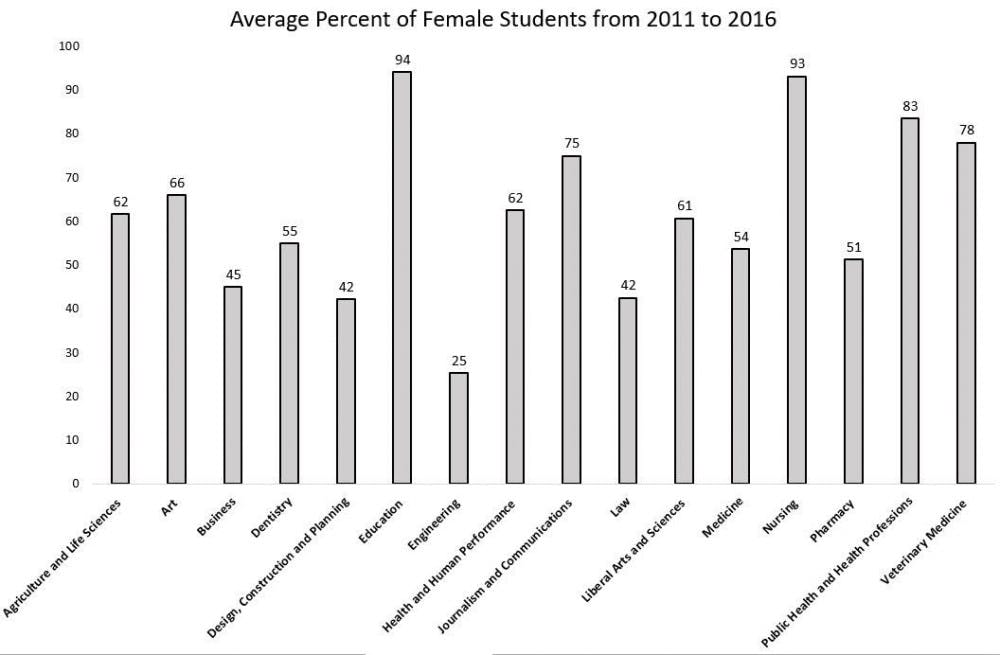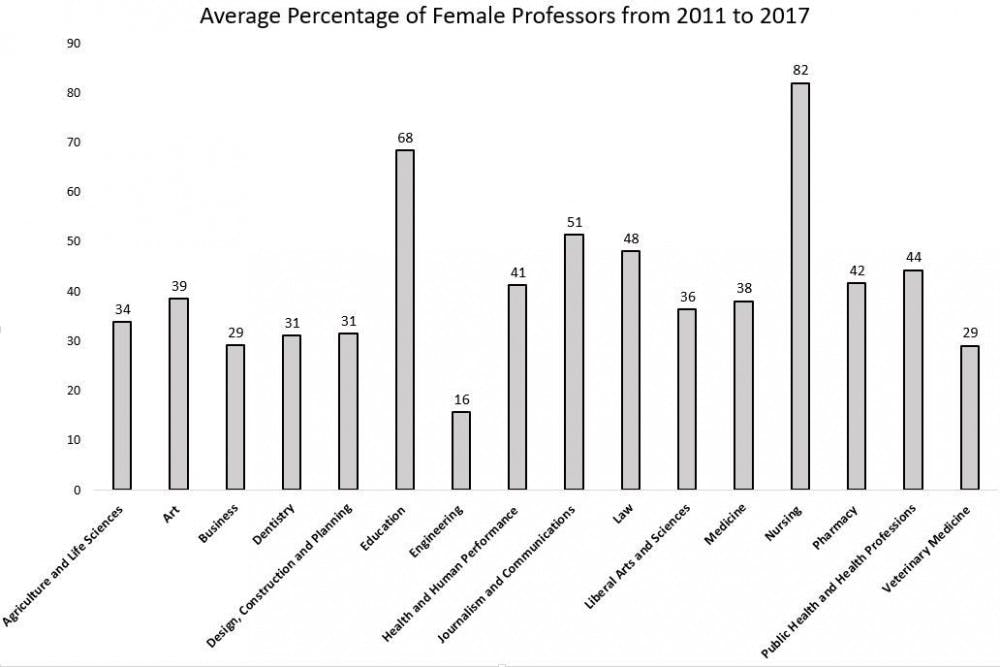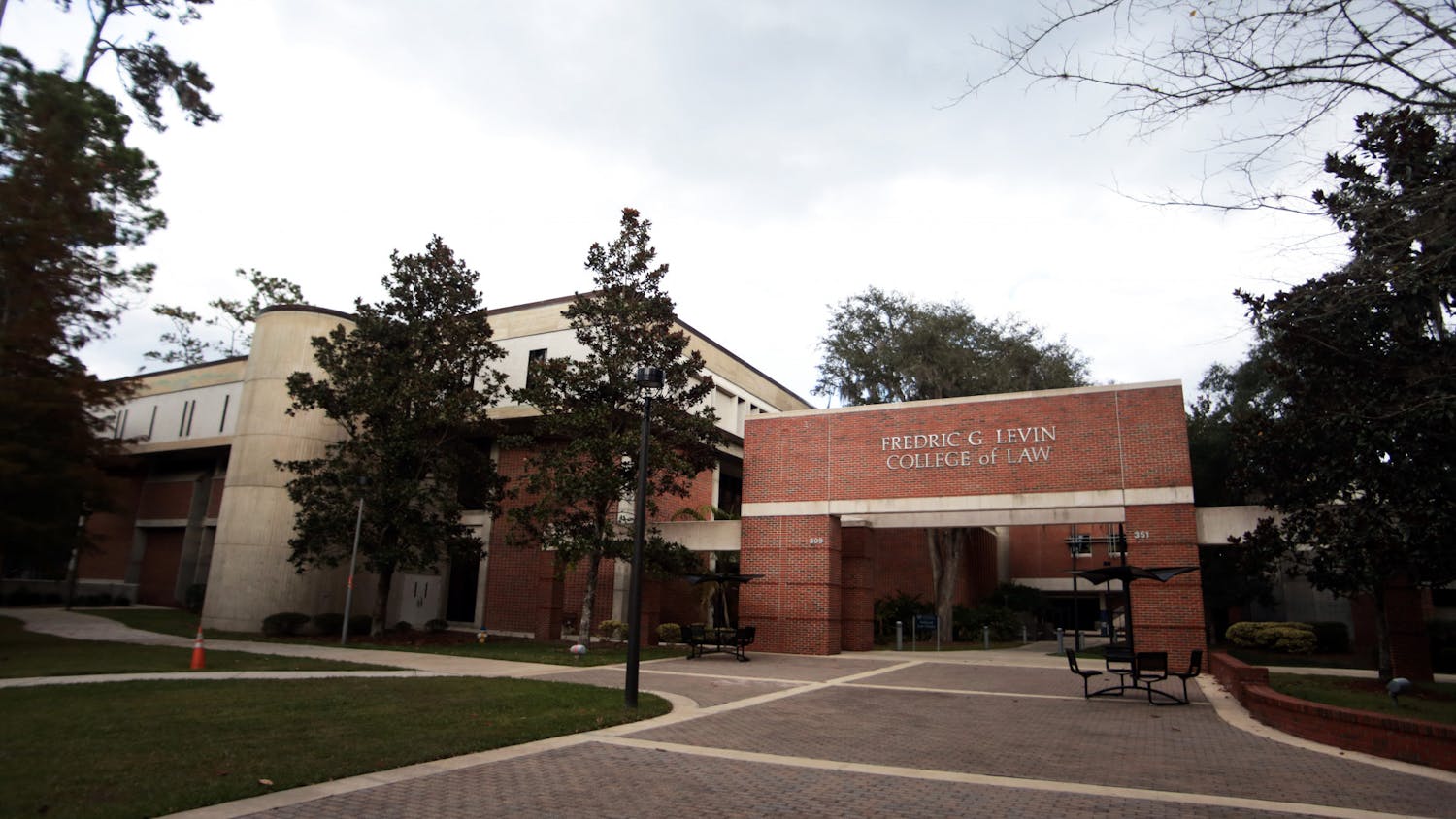About 15 years ago, nursing student Michael Bumbach put on his scrubs, washed his hands and walked into an open-brain surgery performed by a doctor — another man.
But when he walked into the room, the doctor said, “Wow; you’re not the person I expected.”
Bumbach, now a professor at the UF College of Nursing, said he still remembers the doctor’s reaction. He’s received the same sentiment throughout his time as a male nurse practitioner. He knows when people think of nurses, they don’t always picture him but rather a woman in scrubs.

UF’s own nursing college is dominated by women, with an average of about 93 percent of students enrolled being female, according to an analysis of UF enrollment data from the past five years. Other colleges like the UF College of Education and the UF College of Public Health and Health Professions also contain a majority of female students.
While women are prominent in these areas, men maintain a stronghold in the UF Herbert Wertheim College of Engineering, the second-largest college at UF. With 6,976 undergraduate students enrolled in the College of Engineering in Fall 2016, only about 27 percent of them were women.
Bumbach said as a male nurse of more than a decade, people still ask him if he plans to become a doctor. Because he’s a man, they expect him to move beyond nursing, he said, but he wants to remain in nursing and help diversify the profession.
“There’s more and more of a push in nursing to say, ‘Hey, why are we majority homogeneous, why is the nursing force mainly white women?’” Bumbach said.
When Bruce Qian walks into a class in the College of Education, he’s often either alone or accompanied by only one other man.

When the 23-year-old education graduate student enrolled at UF in Fall 2016, he was one of 8,152 men seeking graduate-level degrees in education — compared to 8,665 women.
The College of Education offers graduate-level online degrees, meaning on-campus classes may not reflect the actual ratio of men and women seeking education graduate degrees. But when Qian goes to class in person he said he notices few women.
“Even in China it’s the same picture,” said Qian, who is a Chinese international student. “Most teachers there are female.”
The disparity is worse for undergraduates in the college — which in the last five years has an average of 94 percent female undergraduate students.
In Fall 2016, there were only 30 men enrolled at the undergraduate level, compared to 380 women.
Tom Dana, the associate dean of academic affairs for the college, said the majority of undergraduate students attending UF for education are women interested in elementary and early childhood education.
“It is low; we’re a female dominated field by and large,” Dana said.
A lot of people who become teachers tend to be women.”
Dana said he believes every education college has similar gender diversity numbers.
At the University of California, Irvine, which the U.S. News and World Report ranked alongside UF as the ninth best public university, less than 17 percent of undergraduate students enrolled in its College of Education in Fall 2016 were men, according to the university’s website.
Dana said while the College of Education’s minors tend to attract male students, due to the minors involving math and science education, the college as a whole doesn’t specifically recruit men, but rather looks for candidates interested in the profession.
“We recruit for the best students we can locate,” he said. “We do try to reach out to any group of students that would become good teachers.”
In the UF College of Engineering, three in every four students are men.
Curtis Taylor, the associate dean for student affairs in the College of Engineering, said the college is focused on improving the disparity between men and women. He said UF’s engineering college went from having a 23 percent female enrollment in 2011 to a 28 percent female enrollment in 2017. UF has not yet added Fall 2017 student enrollment data to its online database.
“This is a national problem, it’s a problem that’s been around for a very long time,” Taylor said. “There’s a need for a cultural shift or a cultural change within engineering, as well as within the society about engineering. There still are many perceptions that contribute to less women going into engineering, engineering being a traditional male role.”
At UF, Taylor said the engineering college works to welcome women in the program. Because the college gets no sway over admissions, Taylor said administrators focus on helping students have a better experience while they’re enrolled.
The college hosts different welcoming ceremonies for groups including women, graduate minority students and LGBTQ+ students. They also offer luncheons for women and encourage students to join the Society of Women Engineers, where they can meet mentors and learn from women working in the engineering field.
“That goes a long way, having a mentor and being able to see people that look like you and have similar interests that you’re aspiring to do,” Taylor said.
Taylor said faculty in the college are important in fostering a “culture of inclusion.” In the past six years, the number of female faculty — which includes professors, administrators and researchers — in the College of Engineering went from 11 percent to 19 percent, and Taylor said they’re continuing to focus on diversifying faculty.
“I think the general trend is occurring, one, because our dean, she’s very focused on diversity inclusion, something that is extremely important,” Taylor said.
The lack of female professors when compared to men is common in most of UF’s colleges. From Fall 2011 to Fall 2017, the UF Warrington College of Business Administration had an average of about 29 percent female professors, and the UF College of Design, Construction and Planning had an average of about 31 percent female professors, according to UF faculty data.
Only the UF College of Journalism and Communications, the College of Education and the College of Nursing have had an average majority of female professors since 2011.
The disparity continues into UF’s upper-level graduate programs, like the UF College of Veterinary Medicine, where female professors make up less than 30 percent of the faculty despite female students making up more than three-fourths of the veterinary school’s population.
May Mansy, the president of WiSE, a club that promotes women in science, technology, engineering and mathematics fields, said it’s important to have diverse faculty so women can feel welcome in the classroom.
Mansy, 31, said her friends have sat in on mechanical or aerospace engineering courses and found themselves the only woman in the room. They dropped the class shortly after, feeling uncomfortable.
“It’s a very intangible thing that gets instilled into the psychology of women in general, that if you see a certain field being represented by males most of the time, you don’t feel welcome in there anymore, you don’t feel like you belong anymore, unless you find yourself represented,” she said.
Taylor said it’s important to have a diverse workforce, and he hopes UF’s engineering college can be a model for other schools as they fight the national issue of gender differences in the field.
“It’s what students want,” he said. “And it’s also what companies want. They realize the workforce is a diverse workforce, and if you’re going to have leaders in engineering, you’ve got to have leaders who can inspire people from different backgrounds.”





